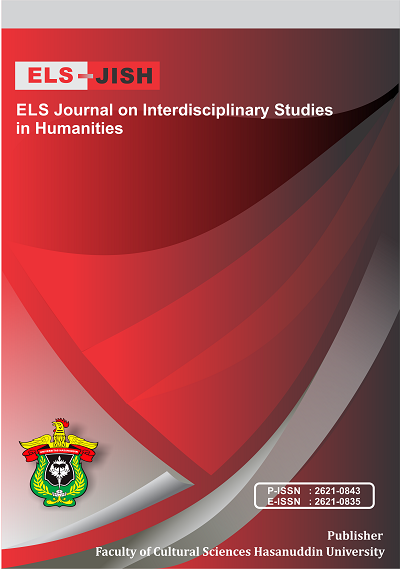Typical Features of Politeness Strategy Performed by Anregurutta (Religious Leader in Pappandangan Maros District of South Sulawesi)
DOI:
https://doi.org/10.34050/elsjish.v3i4.12339Keywords:
Politeness, Aphorisms, Prominent, Anregurutta , ContributeAbstract
Politeness has been considered as a core dimension of social interaction regardless of culture and ethnicity and is a predictor of good etique to prevent offensive reactions from the other interlocutor. The main purpose of this study is to address the politeness strategy use in Buginese Language with special reference to Anregurutta Pappandangan Maros of South Sulawesi. The present research has been set up to account for an ethnographic research and as such research instruments were strictly employed to comply with the nature of resarch design. These include field notes, direct observation, idepth interviews, and recordings. Data were mostly gathered from Anregurutta and the rest from the local people mostly by means of recording and interviews. Greater proportion of the recorded data were from Anregurutta whose daily language of interactional conversation is in Buginese. The recorded conversations were analyzed by means of descriptive analysis and interpretative paradigm.The analysis came up with a series of findings that partly confirm the validity of previous politeness framework, such as Brown and Levinson (1978), and Yassi (1996) with reference to Kinship (K), Distance (D) and Power (P). The finding deviates from the universality of politeness pattern that confirm use of bald-on strategy in non-kinship relation. It appears from the study, bald-on strategy was consistently used in kinship pattern, such as Anregurutta and his wife and daughter. (4.1.5 and 4.1.8). This research gap is most probably due to changes in interactional paradigm as a reult of religious values that has affected the way kindship family interacts. The second finding that has been neglected in the study of poliness of which contributes as the research gap is in reference to metalinguistic of politeness that count spritualism and Islamic suphism as generating motives of having to be polite to other people. The finding may contribute the the development of pragmatics with special reference to politeness strategy in non-european context since these aspects have been neglected in previous studies.
References
Abdullah, H. (1985). Manusia Bugis Makassar: Suatu Tinjauan Historis Terhadap PolaTingkah Laku dan Pandangan Hidup Manusia Bugis Makassar. Jakarta: Inti IdayuPress.
Berman, L. (1998). Speaking Through the Silence: Narrative, Social Conventions, andPower in Java. New York, Oxford: Oxford University Press.
Bonvillain, N. (1993). Language, Culture, and Communication: The Meaning of Mes-sages. Englewood Cliffs: Prentice Hall.
Brown, P & Stephen, L. (1987). Politeness: Some Universals in LanguageUse. Cambridge; New York: Cambridge University Press.
Brown, R., & Albert, G. (1972). ‘The Pronouns of Power and Solidarity.’ In Giglioli,Pier Paolo (ed.). Language and Social Context. Great Britain: Cox & Wyman Ltd,Reading, pp 252-282.
Errington, J. J. (1985). Language and Social Change in Java: Linguistic Reflexes ofModernization in a Traditional Royal Polity. Ohio, USA: Center for InternationalStudies, Ohio University.
Errington, J. J. (1986). ‘Continuity and Change in Indonesian Language Development’. The Journal of Asian Studies, 45(2): 329-353.
Errington, J. J. (1988). Structure and Style in Javanese: A Semiotic View of LinguisticEtiquette. Philadelphia: University of Pennsylvania Press.
Errington, J. J. (1998). Shifting Languages: Interaction and Identity in Javanese Indo-nesian. UK: Cambridge University Press.
Goffman, E. (1967). Interaction Ritual: Essays on Face-to-Face Behavior. Garden City,New York: Anchor Books, Doubleday and Company, Inc.
Holmes, J. (1995). Women, Men, and Politeness. London and New York: Longman.
Hongladaron, K., & Soraj, H. 2005. ‘Politeness in Thai Computer-Mediated Communication.’ In: Robin T. Lakoff and Sachiko Ide (eds.). Broadening the Horizon of Linguistic Politeness. Amsterdam; Philadelphia: John Benjamins Publishing Company, pp. 145-162
Kartomiharjo, S. (1981). Ethnography of Communicative Codes in East Java. Ph.DThesis. Canberra: Research School of Pacific and Asian Studies, the Australian Na-tional University.
Kummer, M. (1992). ‘Politeness in Thai.’ In Richard J. Watts, Sachiko Ide and KonradEhlich (eds.), Politeness in Language: Studies in its History, Theory, and Practice.New York: Mouton de Gruyter, pp 326-336.
Mahmud, M. (2008a). Politeness in Bugis. A Ph.D Thesis. Canberra, Australia: The Aus-tralian National University.Mahmud, Murni. 2008b. ‘Speaking Bugis and Speaking Indonesian in Bugis Society’. RIMA(Review of Indonesia and Malay Affairs), Volume 42, number 2 2008, pp: 67-92.
Mahyuni. (2003). Speech Styles and Cultural Perspectives in Sasak Community. Ph.D The-sis. Melbourne, Australia: University of Melbourne.
Mizutani, O, & Nobuko, M. (1987). How to be Polite in Japanese. Tokyo, Japan:The Japan Times, Ltd.
Ossowski, S. (1963). Class Structure in the Social Consciousness. London: Routledgeand Kegan Paul.
Pelras, C. (1996). The Budis. Oxford UK: Blackwell Publisher
Pizziconi, B. (2003). ‘Re-examining Politeness, Face, and the Japanese Language’ Jour-nal of Pragmatics, 35: 1471-1506.
Rahman, F., & Letlora, P. S. (2018). Cultural Preservation: Rediscovering the Endangered Oral Tradition of Maluku (A Case Study on Kapata of Central Maluku). Advances in Language and Literary Studies, 9(2), 91-97.
Speer, S. A. (2002). ‘Sexist Talk: gender Categories, Participant’ Orientations and Irony’,Journal of Sociolinguistics, 6(3): 347-377.
Turner, B. S. (1988). Status. Milton Keynes: Open University Press.
Speer, S. A. (2002). ‘Sexist Talk: gender Categories, Participant’ Orientations and Irony’,Journal of Sociolinguistics, 6(3): 347-377.
Watts, R. J., Sachiko, I., & Konrad, E. (eds.). (1992). Politeness in Language:Studies in its History, Theory, and Practice. Berlin; New York: Mouton de Gruyter.
Wouk, F. (2001). ‘Solidarity in Indonesian Conversation: The Discourse Marker ya’, Journalof Pragmatics, 33: 171-191.
Zhan, K. (1992). The Strategies of Politeness in the Chinese Language. California, USA:The Regents of the University of California.
Downloads
Published
How to Cite
Issue
Section
License

This work is licensed under a Creative Commons Attribution-NonCommercial 4.0 International License.






